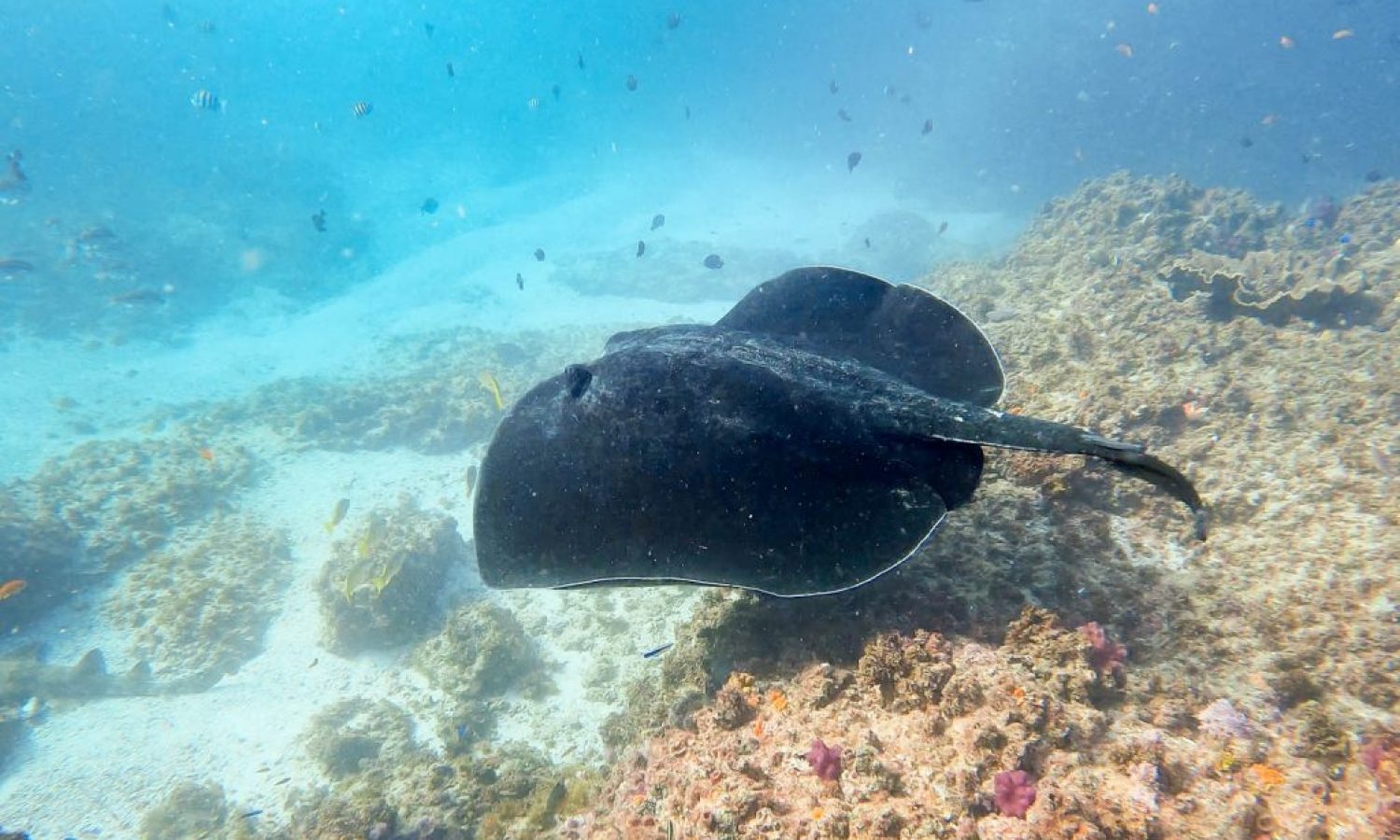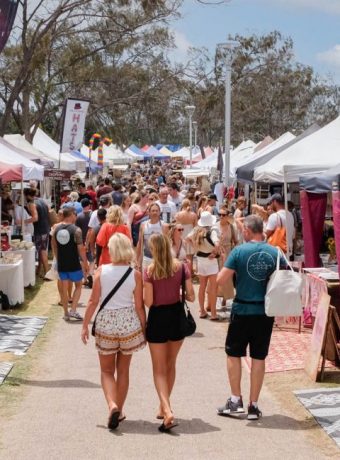Scuba Diving Byron Bay: The Complete Guide
If scuba diving with a mind-blowing variety of marine life is on your bucket list, Byron is the place to tick it off. Here’s everything you need to know to have the best time doing it.
Scuba diving Byron Bay is a must-do if you get the opportunity. One of the top ten dive sites in Australia, Julian Rocks Nature Reserve sits just 2.5 km offshore in an area where temperate and tropical waters meet, making it a magnet for an abundance of aquatic life.
Part of Cape Byron Marine Park, the area is a protected sanctuary for endangered species like the loggerhead turtle and grey nurse shark. And with over 1,000 species of marine life found here, including sharks, rays, turtles, whales, dolphins, corals, and over 500 species of fish, it’s an exceptional place to dive.
To make sure you have the best experience, we’ve rounded up everything you need to know, including dives sites, when to go, dive options available, and who to go with.
The top Byron Bay dive sites
There are six main dive sites surrounding Julian Rocks ranging in depth from 6 to 24 metres, providing fantastic conditions for divers of all experience levels. Since these sites are close to each other, it’s possible to combine a few during your dive time.
If you have any non-divers with you, Julian Rocks is also an epic spot for snorkelling. Just book a guided snorkel tour with your dive operator, and, depending on numbers, they can even come out on the same boat as you.
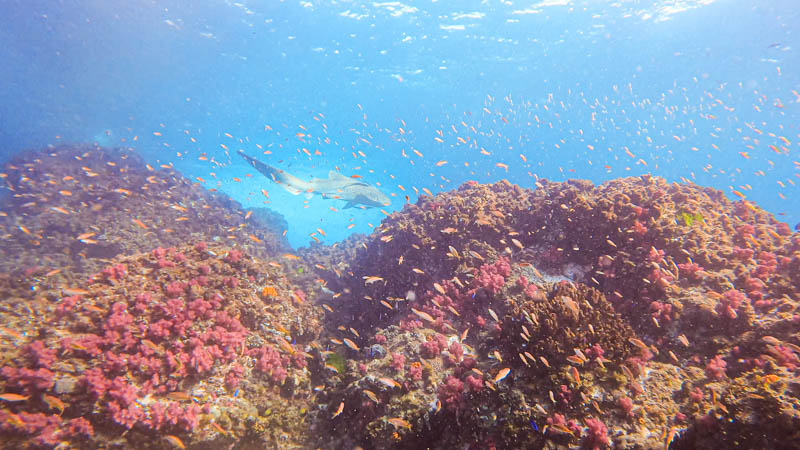
The Nursery
A perfect site for new divers, The Nursery is a shallow, protected area only 5 to 12 metres deep. This site is the single most dived spot at the Rocks, with over 500 species of fish, and serves as a feeding ground for the loggerhead, green sea, and hawksbill turtles. Many juvenile species of fish spend their youth here.
Split Bombie
Suitable for most levels of diver, this site reaches a depth of about 15 metres. It has large bombies with a unique crevice where you can discover schools of fish, wobbegong sharks, and marine invertebrates such as crabs and shrimp. You may also see grey nurse sharks here during the winter months.
The Needles
Located on the southern end of Julian Rocks, The Needles contains large bombies extending up to shallow depths. During the summer months, it’s a feeding station for manta rays and a common area for leopard sharks to appear. The currents and shallow 5-to-15-metre waters here bring rays, turtles, and large schools of fish the entire year, and it’s also a great place to spot nudibranchs.
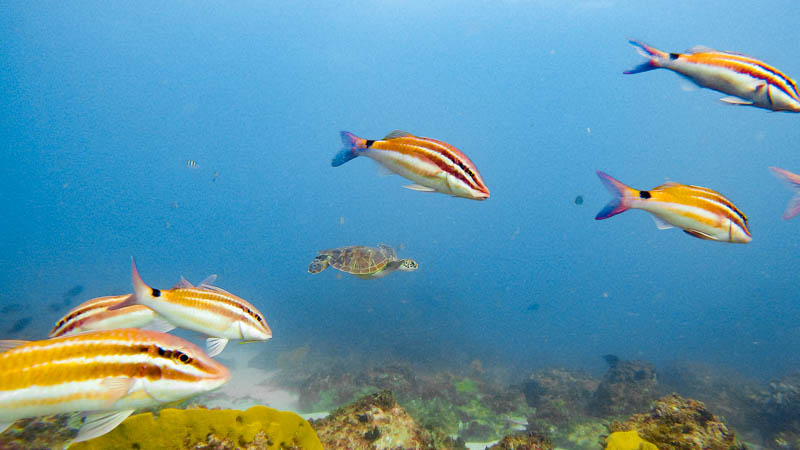
Hugo’s Trench
At an intermediate depth of 15 to 18 metres, Hugo’s Trench contains an incredible variety of fish, eels, and smaller residents like shrimp and nudibranchs, along with larger creatures like wobbegong sharks and bull rays. The setting makes for an interesting dive, with sheer walls rising alongside you and marine life to discover in the various crevices.
The Cod Hole
A small underwater cave located on the northern tip of Julian Rocks, the Cod Hole is a swim-through that ranges in depth from 15 to 21 metres and is a spot for more experienced divers. It shelters grey nurse sharks during the winter months, as well as moray eels and schools of large fish.
The Cray Cave
Found at a depth of 25 metres, this cave is another swim-through suited to more advanced divers. Here you’ll find large rock outcrops surrounded by schools of fish, rays, and sharks. You may see grey nurse sharks in winter, plus bull rays, turtles, cod, and wobbegong sharks throughout the year.

The best time to scuba dive Byron Bay
Happily, there’s never a bad time to scuba dive Byron Bay, which makes it one of the town’s top activities year-round. You can expect to see a spectacular variety and abundance of marine life at any time of year at Julian Rocks, but there are certain seasons where you’ll have a better chance of seeing specific creatures. Check out this list to time your visit if you want to experience any of these special residents:
Grey Nurse Sharks: May to November
Humpback Whales: May to November
Manta Rays: May to December
Leopard Sharks: December to May
Turtles: All year
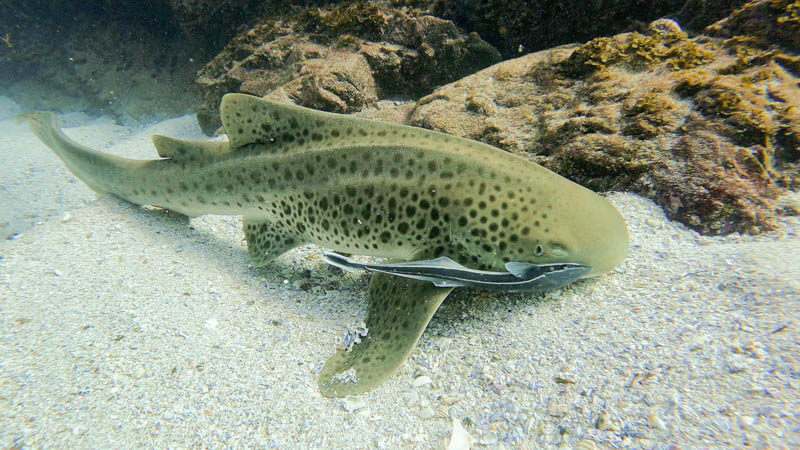
At any time of year, you’ll be able to enjoy large schools of fish such as snapper or kingfish, octopus, turtles, other types of rays and smaller residents like crabs, shrimp, and nudibranchs.
The water temperature will be a consideration during your visit. During the summer months, the average water temperature ranges from 22 to 27 degrees Celsius, while in the winter months, the average temperature is only 18 to 23 degrees. You’ll need a wetsuit at any time of year, but the dive operators in Byron Bay can outfit you with all the protective gear you’ll need, depending on the water temperatures and weather conditions.
Diving options available in Byron Bay
Byron Bay’s dive operators provide the full spectrum of dive excursions and training. No matter what level you’re at – from diving for the first time to becoming a certified diver or even making a career as a divemaster – you’ll find what you need here.
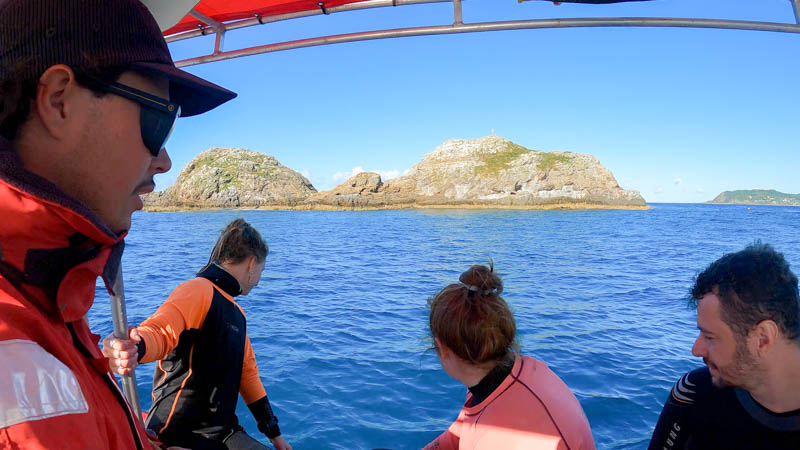
Introductory scuba dives
If this is your first time scuba diving or it’s been a while since you were last under the water, book an Introductory Dive to get started or have a refresher. Your instructors will teach you all the basics you’ll need and provide the proper supervision to ensure you have a safe, fun experience. Intro dives will limit your dive depth to 12 metres, but the abundant natural life at Julian Rocks, even in shallow water, means you’ll still see plenty of aquatic residents!
Certified dives
If you’re already a qualified scuba diver, you can book a certified dive, which gives you access to the full range of Julian Rocks sites. Most of the sites have maximum depths of 18 to 20 metres, so even if you don’t have the Advanced Open Water certification or a deep dive speciality certification, you’ll still be able to see and discover most areas of the sites.
Dive courses
To get the complete experience of scuba diving Byron Bay, take advantage of the full range of courses available at Byron Bay Dive Centre and Sundive. The Open Water Dive Certification courses run over three days at a cost of A$695 to A$745 and include all the training materials and equipment you’ll need to get certified for dives up to 18 metres.
Byron Bay Dive Centre offers certified dive tours and a whole range of courses, from refresher and introductory dives to PADI and SSI training for Advanced Open Waters with a choice of five different diving specialities, Free Diving, Rescue Diver or Divemaster certifications.
Sundive offers a full range of recreational dives plus PADI courses such as Open Waters and Advanced Open Waters, Rescue Diver and Free Diver certifications, plus professional PADI courses to become an Instructor, Assistant Instructor or Divemaster.
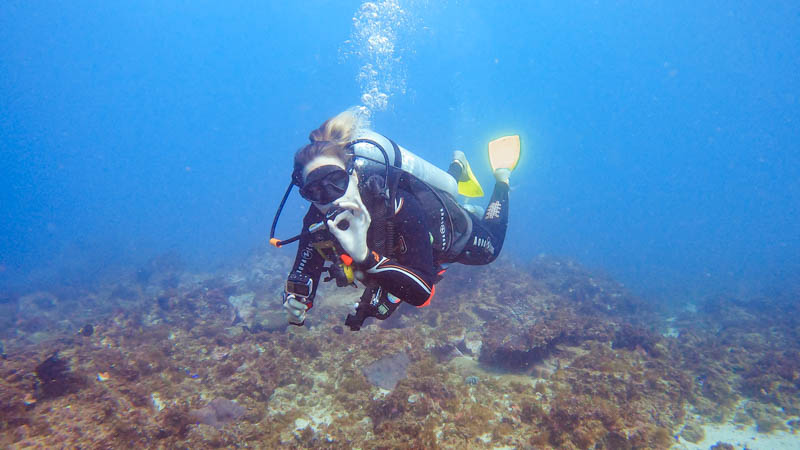
Byron Bay dive operators
Byron Bay Dive Centre
Byron Bay Dive Centre was established over 20 years ago, and its skippers have over 80 years of combined experience. It’s the only dive centre in Byron Bay that teaches both Professional Association of Diving Instructors (PADI) and Scuba Schools International (SSI) courses and offers certifications from both.
It offers dive excursions six days a week, from Tuesdays through Sundays, plus guided snorkelling trips for non-divers. Their vessels carry a maximum of 13 combined visitors and crew and launch from the popular surf beach, The Pass.
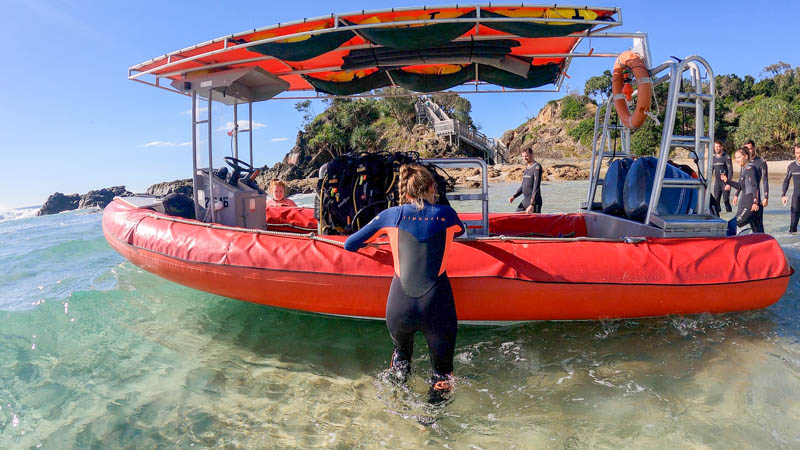
Sundive
In business since 1988, Sundive is Byron Bay’s only dive centre that carries a PDAI 5 Star Instructor Development Centre rating. Five Star Dive Centres are recognised for providing a full range of scuba diving education programs, trip experiences and equipment offerings while embracing environmental responsibility.
Sundive offers three daily trips from Wednesdays through Sundays every week using its fleet of two rigid hull inflatable boats. Trips are limited to six people plus a dive guide. Multiple dives are possible, but boats return home after each excursion, given the proximity of the dive sites to shore.
Blue Bay Divers
Blue Bay Divers is the only operator to offer double dives at Julian Rocks for certified divers on all its trips, so there’s no heading back to shore in between dives. The two 60-minute underwater sessions are linked by a required 60-minute surface interval on the boat, giving you time for rest and snacks. This option is a great choice for more experienced divers who want to maximise their time in the water and already have their open water certifications.
Blue Bay offers Byron Bay’s most spacious and comfortable dive boat, the 8.5-metre Cougar Cat “Bay Warrior”, and carries no more than ten people per trip. Based in Brunswick Heads, Blue Bay is a good option if you’re travelling down from the north and don’t want to travel the extra 20 minutes to Byron Bay.
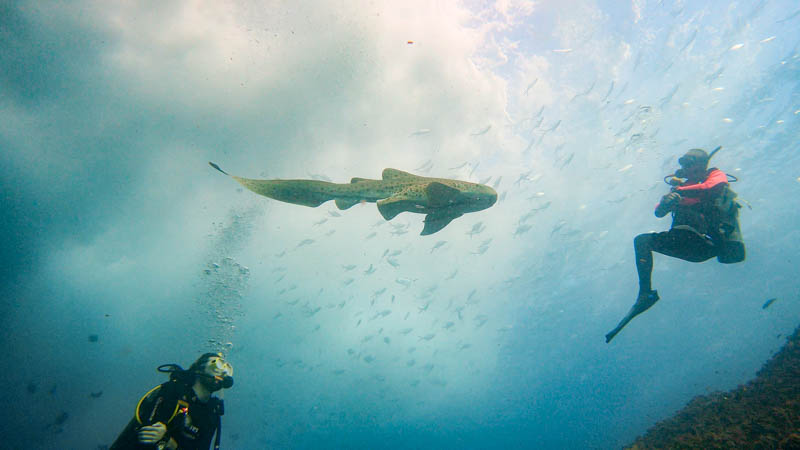
Share the love for scuba diving Byron Bay
So that’s pretty much everything you need to know to have an amazing time scuba diving Byron Bay! If you liked this post or think it would be helpful to someone else, we’d be stoked if you shared it – just use the social buttons at the top.
We hope you find our guide to scuba diving Byron Bay useful. Just so you know, if you book a trip using the links on this page, we may receive a small commission at no additional cost to you. You can view our full disclosure and affiliate policy here.

